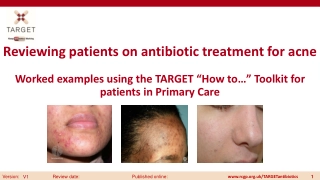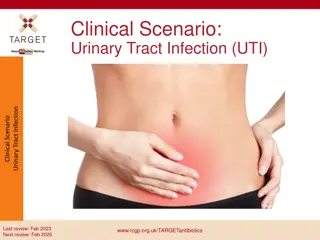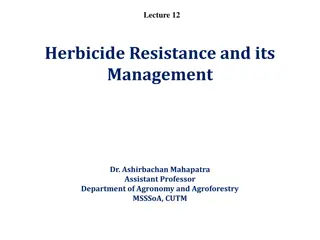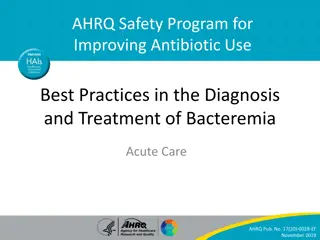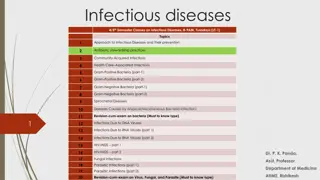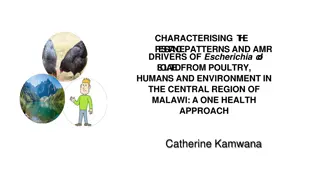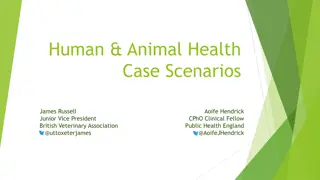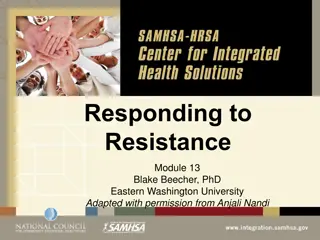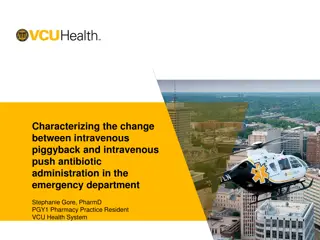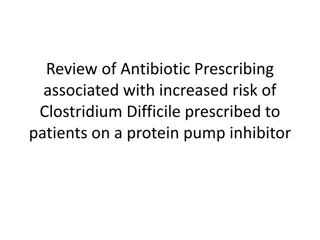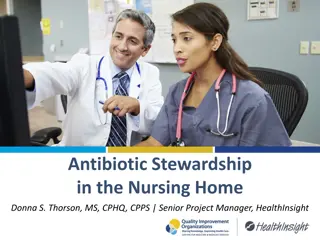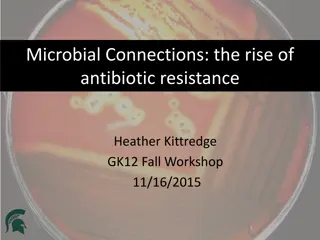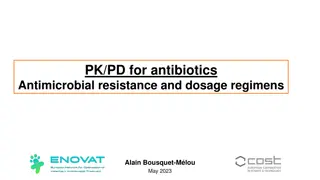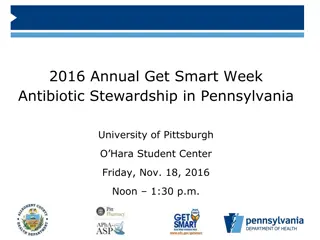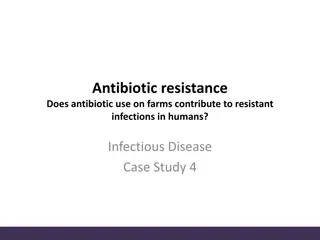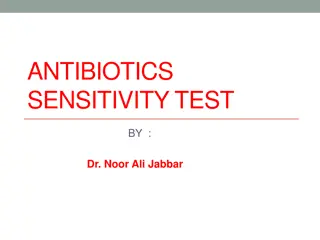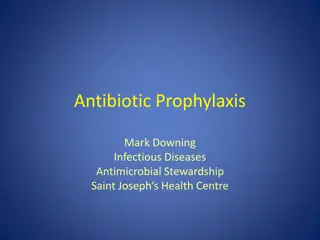Understanding Antibiotic Resistance in Healthcare Settings
This case study follows a 64-year-old female presenting with symptoms of acute pyelonephritis, highlighting the challenge of emerging antibiotic resistance. Despite sensitive urine cultures, the patient's condition worsened, shedding light on the importance of identifying risk factors beyond traditional healthcare exposures. The narrative explores the clinical course, treatment decisions, and implications of beta-lactam antibiotics in combating resistant pathogens.
Download Presentation

Please find below an Image/Link to download the presentation.
The content on the website is provided AS IS for your information and personal use only. It may not be sold, licensed, or shared on other websites without obtaining consent from the author. Download presentation by click this link. If you encounter any issues during the download, it is possible that the publisher has removed the file from their server.
E N D
Presentation Transcript
Multiple Small Feedings Of The Mind Emerging Antibiotic Resistance Ronald W. Flenner, MD, FACP Vice Dean for Academic Affairs James E. Etheridge Jr. Distinguished Professorship Eastern Virginia Medical School
The patient 64yo female PMHx significant for HTN, prior CVA, CAD, CHF, and CKD but negative for previous recurrent infectious illnesses Presents to the ED with 3d history of dizziness, hematuria, R flank pain, and n/v VS: T 96.7, HR 85, RR 18, BP 95/50, SpO2 98% WBC 25.1K CT abd/pelvis: (+) evidence of acute pyelonephritis
The admission IV ceftriaxone begun while awaiting cultures Febrile to 102F after admission Urine cultures returned E. coli sensitive to only amikacin, meropenem, nitrofurantoin, pip/tazo Blood cultures returned GNB Ceftriaxone stopped; meropenem 500mg IVPB Q12h started
The consult ID consulted, on detailed history she had two MD appointments the preceding Wednesday one was to OB/GYN. [She] noted that it was very hot in the exam room and she felt very bad. That night, she started having fevers, abdominal pain, vomiting which worsened over the next few days
Clinical course Blood cultures returned same organism E. coli with same susceptibilities Maintained on Meropenem 500mg IV Q12h Tmax peaked at 103F on hospital day 4 (Abx day 3) Defervesced slowly WBCs peaked day of admission but remained elevated without thrombocytosis (range 14.2-23.4) Cr baseline 1.4-1.6 During admission, peaked at 6.4 on hospital day 5 (abx day 4) but has trended down since
So why is this case clinically important? Expected risk factors: Immunocompromised status Prolonged hospital/SNF stay Chronic indwelling urinary catheter Repeated courses of abx Her risk factors: none of the above exposure to healthcare a few hours before symptom onset
The rise of the beta-lactamases First penicillinase in 1944 Early 1980s: 3rd-gen cephalosporins developed in response to spread of beta-lactamases 1983: first report of a beta-lactamase able to hydrolyze new cephalosporins 1986: first big outbreak of ESBL-producing bacteria in France (first in Germany & England, but majority of occurrences in France) 1988: first reports of ESBL-producing bacteria in US
ESBL-producing bacteria Extended-spectrum beta-lactamase-producing organisms Most often Escherichia coli and Klebsiella pneumoniae (>75% of studies on ESBL have addressed K. pneumoniae) Produces an enzyme (beta-lactamase) via plasmid that destroys the drug most ESBLs able to hydrolyze penicillins, broad-spectrum cephalosporins, monobactams
The way they work Serine-based mechanism of action (classed by amino acid sequence Ambler classes A, C, D) Serine residue near active site of enzyme irreversibly reacts with beta-lactam ring This inactivates the beta-lactam and regenerates the enzyme Can be inhibited by clavulanic acid Ambler class B use a metalloenzyme as a substrate and can hydrolyze 3rd-gen cephalosporins E.g., Stenotrophomonas maltophilia Not inhibited by clavulanic acid, tazobactam Inhibited by EDTA (heavy metal chelator)
Types of beta-lactamases TEM-1, TEM-2, SHV-1: classic beta-lactamases Oft found in Enterobacteriaceae Active against early penicillins and 1st-gen cephalosporins SHV-2: G238S this mutation single-handedly accounts for ES properties TEM-3: extended substrate profile, likely due to overuse of 3rd- gen cephalosporins and aztreonam Over 100 TEM variants; most qualify as ESBL most are susceptible to suicide inhibitors (clavulanic acid) CMT1-4: able to hydrolyze 3rd-gen cephalosporins but also have inhibitor resistance
The problems with cultures MIC of cephalosporins often within susceptible range Variations due to: genetic differences in resistance determinants varying levels of gene expression variations in spectra of enzymatic activity inoculum effect In vitro: directly proportional rise in MIC of cephalosporins with increase in ESBL-organism inoculum
Co-resistance Plasmids are transferable from strain to strain and between bacterial species Often occur with: plasmids causing aminoglycoside resistance AmpC beta-lactamase Associated with increasing fluoroquinolone resistance
Treatment Theoretically beta-lactamase inhibitors should be effective, BUT: Hyperproducing strains may overcome inhibition Possible presence of AmpC enzyme will make it resistant to inhibitors Drug of choice: Carbapenems
Concerns for the future Increasing incidence of carbapenem-resistant bacterial species, especially Stenotrophomonas and Pseudomonas CRE: carbapenem-resistant Enterobacteriaceae IMP-1, IMP-7: Beta-lactamases capable of carbapenem hydrolysis Plasmid-mediated Two types, both metalloenzymes KPC-1: found in a strain also harboring SHV-29 (ESBL) Possible mechanism: change in affinity of PBPs for carbapenems
CREs in the community Study by Ahmad, et al: 8 patients with carbapenem-resistant K. pneumoniae following imipenem No other antibiotic options; six of the eight patients died Seattle s Virginia Mason Medical Center 32 cases, 11 deaths Transmitted via endoscopes Consider tigecycline, polymixins if treating carbapenem- resistant klebsiellae No cross-resistance; mechanisms of resistance are different
Take-home points Extended-spectrum beta-lactamases pose a significant risk to our ability to combat infections with the antibiotics we have ESBLs come in a variety of types that affect their sensitivities to different drugs Carbapenems are your drug of choice when treating ESBLs If you re facing a carbapenem-resistant ESBL, use tigecycline or Colistin (or something that has a different mechanism of resistance) Always promote good antibiotic stewardship!
MRSA Described in 1961 Increase in both Healthcare and Community settings HA- MRSA Infections occurring > 48 hours following hospitalization Surgical site infections
HA- MRSA Routinely implicated in nearly every type of hospital acquired infection Biofilm Risk factors: Antibiotic use Prolonged hospitalization ICU Hemodialysis
HA- MRSA Risk factors continued MRSA colonization Proximity to those with MRSA infection or colonization
HA- MRSA Higher mortality, longer hospital stays, higher costs vs. MSSA BSI secondary to MRSA 1.5 2.0 fold more likely to die compared with BSI due to MSSA Higher rates of AKI, hemodynamic instability , and prolonged ventilator dependence compared to MSSA
CA- MRSA Occurs in the absence of healthcare exposure Initially reported in the 1980 s in IVDA population Now most common cause of SSTI in U.S. Most carry SCCmec type IV or V genes for cytotoxin Panton- Valentine lukocidin confers enhanced virulence
CA- MRSA Risks Animals may carry MRSA Many patients have no risk factors
HA- MRSA/CA- MRSA Blurred epidemiologic distinction CA- MRSA may be replacing traditional hospital-acquired strains
MRSA Antibiotic use Cephalosporins Fluoroquinolones HIV Infection Hemodialysis LTCF
MRSA Transmission HC- MRSA Transiently contaminated hands of HCW Contaminated environmental surfaces CA- MRSA Direct contact with colonized or infected individual
Staphylococcal Colonization Ecologic niche of S.aureus is the anterior nares. Carriage rates average 20-25% (increased in diabetes, dialysis, IVDA). Carriers have a 2 to 10- fold increased risk of surgical site or IV catheter infections. 30-100% of SSI in nasal carriers are caused by the strain carried in the nose. 40 different decolonization regimens have been studied over the last 60 years.
MRSA Colonization Decolonization was attempted with rifampin as part of a comprehensive program to control MRSA in a VA Nursing Home Care Unit. For rifampin, 92% of baseline isolates were sensitive; after treatment only 43% were sensitive. Decolonization was ineffective and potentially hazardous . Strausbaugh LJ. Infect Control Hosp Epidemiol 1992;13:151-9.
Mupirocin Decolonization for MRSA Mupirocin applied to the anterior nares for 5 days can reduce colonization by 90-95%. Especially valuable in the treatment of HCW s linked to nosocomial MRSA infections. Significantly better than bacitracin (94 vs. 44% eradication). May be much lower clearance with multisite carriage (wounds,etc.): 21-44%.
MRSA Colonization: Mupirocin All 321 residents of a VA LTCF (Ann Arbor) were cultured; MRSA (+) received mupirocin ointment to nares and wounds. MRSA was rapidly eliminated by the end of 1 week. Even with weekly maintenance mupirocin, 40% recurred and 10.8% became mupirocin resistant. Facility colonization rates did not change. Kauffman CA. Am J Med 1999;94:371-8.
Mupirocin for MRSA Prevention of CAPD catheter infections (exit site): decreases GPC exit site infections, increases GNR infections. Ritzau J. Perit Dial Int 2001;21:471-9. Cardiac Surgery: 67% reduction in surgical site infections compared to historic controls; cost $12.47/patient vs. $81,018/deep infection) Ann Thorac Surg 2001;71:1572-8.
Take Home: MRSA and Mupirocin Highly effective for individuals with nasal colonization, esp. HCW assoc with nosocomial infections. Less successful with colonization other than nares and attempts at decreasing facility wide colonization rates. Resistance most likely with long term use. Areas of interest: preoperative to decrease SSI s and dialysis (CAPD and HD).
Enterococci Normal intestinal flora of almost all animals from cockroaches to humans with typical concentrations of 108/gram of stool. 2 predominant species: E. faecalis and E.faecium. E.faecalis causes 80% of human infections, but only 2% are Vancomycin resistant (VRE). E.faecium causes 20% of human infections, but 52% are VRE. Huycke M. Emerg Infect Dis 1998;4:239-49.
Enterococci and Synercid E. faecium are almost always sensitive to Synercid (90% of VRE isolates). E.faecalis are almost always resistant to Synercid (10% of all VRE). Mechanism of resistance is unknown but similar observations have been reported for Virginiamycins M and S. Collins L. AAC 1993;37:598-601.
Linezolid (Zyvox) First antibiotic from the oxazolidinone class. Inhibits protein synthesis at the bacterial ribosome and is bacteriostatic against Staphylococci and Enterococci. Active against VRE (both E. faecium and E. faecalis), MRSE and MRSA. Cure rates have been comparable to vancomycin. Medical Letter 2000;42:45-6 (issue #1079)
Linezolid (Zyvox) Usual dose is 600 mg. Q12H. Available in 600 mg. tablets, oral solution and IV formulation. Each 600 mg. tablet is $53 and a 600mg. IV vial is $72. No dosage adjustment with renal or hepatic failure.
Linezolid (Zyvox) Most common adverse events have been nausea, vomiting and diarrhea. Reversible thrombocytopenia has been reported with prolonged use; monitoring of platelet counts has been recommended if treatment is >2 weeks. Weak non-selective reversible inhibitor of monoamine oxidase; patients should avoid foods rich in tyramine which could result in severe hypertension.
Linezolid Resistant VRE Liver transplant recipient with VRE infection treated with linezolid which became linezolid resistant, but remained synercid sensitive. Strain was transmitted to 6 others, none had overt infection or were treated with linezolid. Associated with a 23S rDNA mutation which has also been described in a linezolid resistant S. aureus. Herrero I.NEJM 2002;346:868-9.
Is there ever justification in attempting to eradicate colonization of VRE/MRSA in a patient?
Where are patients colonized with VRE? For patients with VRE bacteremia: 100% had stool colonization. 86% had skin colonization. Beezhold D. Clin Infect Dis 1997;24:704-6
VRE Colonization 70% of patients colonized with VRE go undetected without active surveillance. VRE colonized and VRE infected have similar amounts of VRE in stool (108/gm of stool). Some remain colonized for > 1 year.
Bacitracin for VRE Colonization Not routinely used to treat systemic infection. Non-absorbable antibiotic first isolated from a Bacillus species. Highly active against gram positives. Acquired resistance unusual. .
Bacitracin for VRE 8 patients treated with bacitracin 25,000u BID x 10d; 5 were repeatedly negative after one course (1 required 2 courses). Chia J. Clin Infect Dis 1995;21:1520. 4 LTC facility residents received bacitracin 75,000u QID x 14d; 3 of 4 cleared VRE during therapy, 2 became (+) after 48hrs. Armstrong-Evans M. Infect Control Hosp Epidem 1999;20:312-17.
Bacitracin for VRE All colonized inpatients were treated with bacitracin 25k or 50k units QID. VRE was suppressed in stools in 50% and 75% in the low and high dose arms ,respectively. Long term eradication was only 25% and 40%. McGeer A. 35th ICAAC San Fran 1995 Ab# J142.


